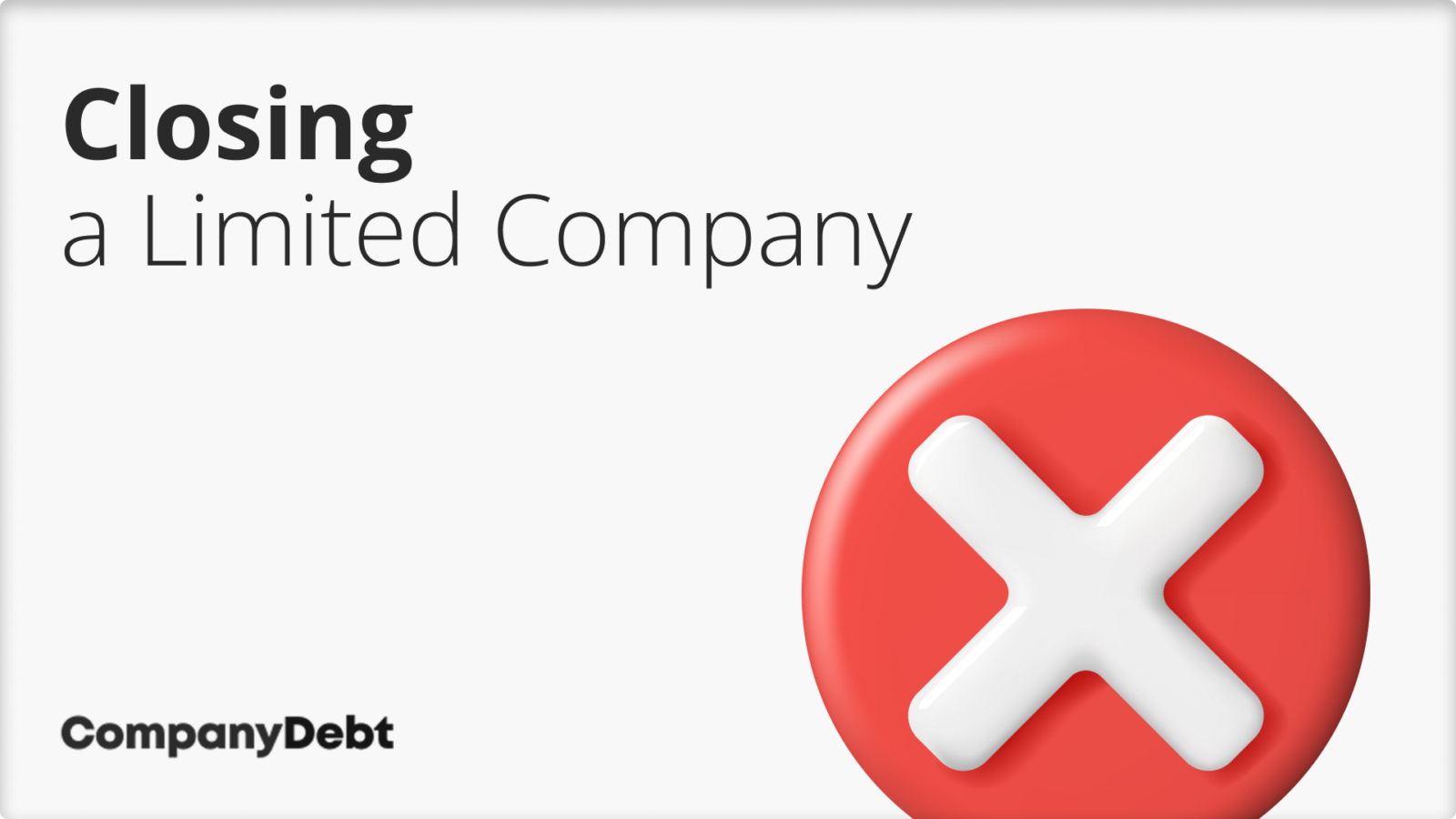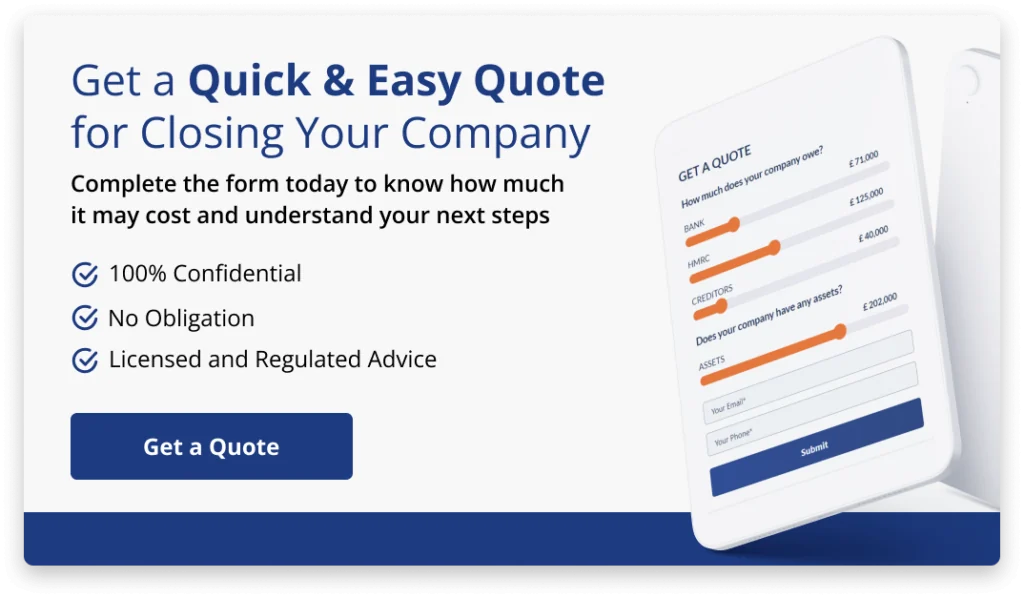How to Close a Limited Company
How you close the company depends on whether it can pay its bills. Below, I cover both solvent and insolvent closure processes.
- How to Close a Limited Company Which Can Pay Its Bills (Solvent)
- How to Close a Limited Company Which Can’t Pay Its Bills (Insolvent)
- How Long Does it Take to Close a Company?
- What Permissions do I Need to Close my Company?
- How to Close a Limited Company That Never Traded
- Do I Need to Notify HMRC if I Want to Close a Limited Company?
- How to Make a Company Dormant instead of Closing it
- Do I Need to tell HMRC my Company has Been Closed if it Never Traded?
- How do I Close a Company if There’s no Director?
- Closing a Limited Company FAQs
How to Close a Limited Company Which Can Pay Its Bills (Solvent)
If your limited company is solvent and you wish to close it down, you have two options: voluntary strike off or a process known as members’ voluntary liquidation (MVL).
While both will result in your company’s closure, an MVL offers significant tax advantages if your company has more than £25,000 in retained assets.
(a) Voluntarily Strike Off a Solvent Company
A voluntary strike off[1]Trusted Source – GOV.UK – Strike off Your Limited Company From the Companies Register is a process whereby a company requests to be removed from the official register at Companies House, dissolving the company. It is suitable for solvent companies that have ceased trading and have no assets or liabilities.
Eligibility
Before applying for a strike off, ensure your company meets the following criteria:
- it hasn’t traded in the last three months
- it has no outstanding debts (including to HMRC, suppliers, and employees)
- it is not involved in any legal proceedings or threatened with liquidation.
Once eligibility is confirmed, you can apply to Companies House either online or by post, accompanied by a nominal fee.
Process
The process of a voluntary strike off involves the following steps:
- The directors must ensure that the company has ceased trading, has no assets or liabilities, and is not subject to any legal proceedings.
- The directors must obtain the agreement of all shareholders to close the company.
- Form DS01 (Application for Strike Off) must be completed and signed by a majority of the directors.
- The form is submitted to Companies House along with the £10 filing fee.
- A copy of the application must be sent to all interested parties, such as shareholders, creditors, and employees, within 7 days of submitting the form.
- The company name is published in the Gazette, allowing 2 months for objections.
- If no objections are received, the company is struck off the register and ceases to exist.
It’s important to note that a company can be restored to the register if an objection is received or if it is discovered that the company had outstanding assets or liabilities at the time of the strike off.
After your company is struck off, you must keep all business documents for 7 years. This includes bank statements, invoices, and receipts. If your company had employees, you must also keep employee records for the same period.
>>Read more about Objections to Company Strike Off
Cost
Striking off a company directly through Companies House is the least expensive option: It costs £8 to apply online, or £10 for a paper application.
(b) Members’ Voluntary Liquidation of a Solvent Company
Members’ voluntary liquidation (MVL) is a formal procedure for closing a solvent limited company, best suited for when assets exceed £25,000[2]Trusted Source – GOV.UK – Liquidate a Company you do not Want to run Anymore. An MVL can offer significant tax advantages for distributions made during the process.
Eligibility
To qualify for an MVL, a company must be solvent and able to settle all its debts within 12 months.
The process begins with the company’s shareholders passing a resolution for voluntary liquidation. Directors must then prepare and swear a Declaration of Solvency, which includes a detailed statement of the company’s assets and liabilities.
Process
The process of a voluntary strike off involves the following steps:
- The directors must ensure that the company has ceased trading, has no assets or liabilities, and is not subject to any legal proceedings.
- The directors must obtain the agreement of all shareholders to close the company.
- Form DS01 (Application for Strike Off) must be completed and signed by a majority of the directors[3]Trusted Source – GOV.UK – Strike off a Company from the Register (DS01).
- The form is submitted to Companies House along with the £10 filing fee.
- A copy of the application must be sent to all interested parties, such as shareholders, creditors, and employees, within 7 days of submitting the form.
- The company name is published in the Gazette, allowing 2 months for objections.
- If no objections are received, the company is struck off the register and ceases to exist.
It’s important to note that a company can be restored to the register if an objection is received or if it is discovered that the company had outstanding assets or liabilities at the time of the strike off.
Tax Benefits
The tax benefit of an MVL comes through something called Business Asset Disposal Relief[4]Trusted Source—GOV.UK—Business Asset Disposal Relief (formerly Entrepreneurs’ Relief), which allows qualifying shareholders to pay a reduced Capital Gains Tax rate of 10% on the first £1 million of eligible gains (lifetime limit).
Cost
Fees typically start from £3,000 but can increase significantly depending on the size and complexity of the company.

How to Close a Limited Company Which Can’t Pay Its Bills (Insolvent)
(a) Creditors’ Voluntary Liquidation of an Insolvent Company
Creditors’ Voluntary Liquidation (CVL) is a formal procedure for voluntarily closing an insolvent company. This method allows company directors to take proactive steps in managing the closure process, preserving some control and potentially safeguarding their reputations.
Process
The process of a Creditors’ Voluntary Liquidation (CVL) involves the following steps:
- The directors must determine that the company is insolvent and unable to pay its debts.
- A board meeting is held to discuss the company’s financial situation and propose liquidation.
- Shareholders pass a special resolution to wind up the company and appoint a liquidator.
- The directors must provide a statement of affairs to the liquidator, detailing the company’s assets and liabilities.
- The liquidator calls a creditors’ meeting within 14 days of appointment, where creditors can vote on the liquidator’s appointment and discuss the statement of affairs.
- The liquidator takes control of the company’s assets, realizes them, and distributes the proceeds to creditors in order of priority.
- The liquidator investigates the company’s affairs and reports any misconduct to the appropriate authorities.
- Once the liquidation process is complete, the liquidator calls a final meeting of creditors and members to present the account of the winding-up process.
- The liquidator sends the final account to Companies House and the company is dissolved 3 months later.
Cost
The costs of Creditors’ Voluntary Liquidation (CVL) vary, with professional fees generally starting from £4,000 upwards, influenced by the company’s size, number of creditors, and asset disposition.
(b) Compulsory Liquidation by Creditors
Compulsory liquidation is a mandatory form of liquidation that is typically initiated by creditors or HM Revenue & Customs (HMRC) when a company fails to pay its debts. This process forces a company to cease operations and dissolve officially via a Winding up Order.
Process
The process of Compulsory Liquidation involves the following steps:
- A creditor, shareholder, or director petitions the court to wind up the company, usually due to insolvency.
- The court hears the petition and, if satisfied, issues a winding-up order.
- An official receiver (a government employee) is appointed to take control of the company’s assets and investigate its affairs.
- The official receiver may appoint a private liquidator to assist with the liquidation process.
- The liquidator takes control of the company’s assets, realizes them, and distributes the proceeds to creditors in order of priority.
- The liquidator investigates the company’s affairs and reports any misconduct to the appropriate authorities.
- The official receiver or liquidator may call meetings of creditors and contributories (shareholders) to discuss the progress of the liquidation.
- Once the liquidation process is complete, the liquidator sends a final account to Companies House and the company is dissolved 3 months later.
Cost
In compulsory liquidation, the company does not directly bear the costs. The petitioning creditor covers the court fees. The Official Receiver’s fees and expenses are paid from the company’s assets, if available, or by the government, if the company lacks sufficient funds.
(c) Putting a Company into Administration
While administration is often a step towards closure, the primary goal of entering administration is to allow the company to continue operating while a solution is sought. If the company’s situation is irrecoverable, administration helps ensure that the company’s assets are dealt with in a manner that maximises returns for creditors.
Process
An insolvency practitioner is appointed as the administrator. Their role is to take control of the company and manage its affairs to protect the interests of the creditors. The administrator assesses the company’s situation and decides the best course of action, which could include restructuring, selling the business, or winding down operations.
Once a company enters administration, it gains a moratorium against legal actions from creditors. This provides a period of protection during which no legal action can be taken against the company without the court’s or the administrator’s permission, allowing some breathing space to formulate a plan.
If rescue or recovery is not viable, the administration process can lead to a more orderly closure of the company.
>>Read our full article on administration
Costs
Going into administration typically involves substantial costs, including the fees for appointing an insolvency practitioner, legal expenses, and any associated administrative costs. These costs are usually paid out of the company’s assets, which can reduce the amount available for distribution to creditors.
How Long Does it Take to Close a Company?
The time it takes to close a company in the UK depends on the process used and the company’s complexity.
| Closure Method | Typical Duration |
|---|---|
| Voluntary Strike Off | 3-6 months |
| Members’ Voluntary Liquidation (MVL) | 6-12 months |
| Creditors’ Voluntary Liquidation (CVL) | Around 12 months |
| Compulsory Liquidation | Often exceeds 12 months due to complexity |
What Permissions do I Need to Close my Company?
- Striking off: You must have the agreement of all company directors and inform any shareholders, creditors, and employees. The company should not have traded or sold off any stock in the last three months.
- Members’ Voluntary Liquidation (MVL): Requires a declaration of solvency from the directors, affirming the company can pay its debts within 12 months. Shareholders must also approve the liquidation, typically requiring a 75% majority vote in favour.
- Creditors’ Voluntary Liquidation (CVL): This method requires a vote by the shareholders to agree on liquidation, followed by a meeting with creditors to appoint a liquidator.
- Compulsory Liquidation: Initiated by creditors through a court order, so the company itself does not need to obtain permission, but must respond to legal actions taken by creditors.
How to Close a Limited Company That Never Traded
If you have a limited company that never traded, you can close it through a simple strike off process:
- Ensure the company has no assets or liabilities and has never traded.
- All directors must agree to close the company.
- Complete Form DS01 (Strike Off Application) and have it signed by a majority of the directors.
- Submit Form DS01 to Companies House with the filing fee (£44 for a paper application and £33 for a digital application).
- Distribute a copy of the application to all interested parties (e.g., shareholders, creditors) within 7 days of submission.
- Companies House will publish a notice in the Gazette, allowing 2 months for objections.
- If no objections are received, the company will be struck off the register and dissolved.
Remember to keep company records for at least 7 years after the strike off. If the company has any assets, these should be transferred or sold before applying for strike off, and any profits may be subject to Capital Gains Tax or Income Tax.
Do I Need to Notify HMRC if I Want to Close a Limited Company?
You will need to notify HMRC if you decide to dissolve (Strike Off) a limited company.
If you are closing a limited company via MVL or CVL, the appointed Insolvency Practitioner (IP) has the responsibility of notifying HM Revenue and Customs (HMRC) as part of the liquidation process.
How to Make a Company Dormant instead of Closing it
To make your company dormant[5]Trusted Source – GOV.UK – Dormant Companies and Associations, ensure that all clients and employees are aware that you are ceasing trading and that any agreements or contracts are to be terminated.
Then you can follow these steps:
- Notify HMRC that your company is dormant. You can do this online or by phone.
- File your dormant company accounts with Companies House. You can do this online or by post.
- Submit a confirmation statement to Companies House each year. You can do this online or by post.
Do I Need to tell HMRC my Company has Been Closed if it Never Traded?
Yes, if your company has been closed and it never traded, you still need to inform HM Revenue and Customs (HMRC) about the closure. Even if the company had no business activities or tax liabilities, HMRC should be notified to ensure their records are updated, and no further tax obligations or filings are expected from the company.
How do I Close a Company if There’s no Director?
If a company doesn’t have a director, shareholders must appoint a new one to manage the closing process. Companies House will eventually strike off a company without a director, but this can complicate managing company assets.
The newly appointed director can then close the company through the appropriate process, such as a Creditors’ Voluntary Liquidation (CVL) or Voluntary Strike Off, based on the company’s financial situation.

How Company Debt Can Help
Closing your company can be a complex and stressful process, but you don’t have to face it alone. Company Debt is here to provide the expert support and guidance you need.
- Direct support from experienced insolvency practitioners
- Tailored solutions for your unique situation
- We handle the complexities, reducing your stress
- Confidential service with your privacy as our priority
If you need help understanding the best way forward for your company, use our live chat during working hours or call us on 0800 074 6757. Our team has helped thousands of directors navigate difficult financial circumstances.
Closing a Limited Company FAQs
Can I close my company if it has outstanding debts?
Yes, via a process called creditors voluntary liquidation, which is where the directors voluntarily opt to liquidate. The use of an insolvency practitioner is mandatory to ensure fair play for creditors.
How can one reinstate a company after closure?
To reinstate a company after closure, an application must be made to the court for a restoration order. This requires submitting evidence explaining why the company was dissolved and how you meet the criteria for restoration, as well as settling any outstanding debts or filing requirements.
What are the legal requirements for notifying creditors about a company closure?
When closing a company, directors must inform all creditors about the intended closure. This is usually done by sending a written notice and, if the company is being voluntarily wound up, advertising the resolution to wind up in The Gazette.
What are the consequences of not following proper procedures during company closure?
Failure to follow proper procedures during company closure can result in legal and financial penalties for directors, including personal liability for company debts, fines, or disqualification from serving as a director in the future.
The primary sources for this article are listed below, including the relevant laws and Acts which provide their legal basis.
You can learn more about our standards for producing accurate, unbiased content in our editorial policy here.
- Trusted Source – GOV.UK – Strike off Your Limited Company From the Companies Register
- Trusted Source – GOV.UK – Liquidate a Company you do not Want to run Anymore
- Trusted Source – GOV.UK – Strike off a Company from the Register (DS01)
- Trusted Source—GOV.UK—Business Asset Disposal Relief
- Trusted Source – GOV.UK – Dormant Companies and Associations





